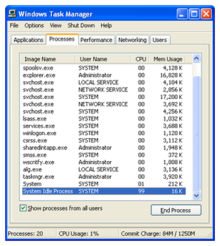| Revision as of 19:48, 22 August 2007 edit67.90.197.194 (talk) Removed vandalism at the bottom and consolidated repetition← Previous edit |
Revision as of 19:50, 22 August 2007 edit undo67.90.197.194 (talk) Commented out the thread priority paragraphs, which really ought to be moved out into their own articleNext edit → |
| Line 2: |
Line 2: |
|
] |
|
] |
|
In ]-based operating systems, the '''System Idle Process''' is the system ]: it tracks how much of the ]'s time is being utilized and issues the ] instruction to cut the processor's power usage. In the ], it provides information about how heavily loaded the CPU is. In a system that is not very busy, such as a typical workstation waiting for input, the idle process accounts for over 90% of the CPU. |
|
In ]-based operating systems, the '''System Idle Process''' is the system ]: it tracks how much of the ]'s time is being utilized and issues the ] instruction to cut the processor's power usage. In the ], it provides information about how heavily loaded the CPU is. In a system that is not very busy, such as a typical workstation waiting for input, the idle process accounts for over 90% of the CPU. |
|
|
|
|
|
<!-- |
|
|
THIS IS INTERESTING BUT DOESN'T BELONG HERE. IT BELONGS IN AN ARTICLE ON WINDOWS THREAD PRIORITIES. |
|
|
|
|
|
There are 32 levels of priority: 1 through 15 for the common applications, 16 through 31 for critical threads, and a priority 0 that is used only for the system idle process. The higher the number, the greater the priority. Priorities 1 through 15 are the dynamic priorities that typical applications get assigned. The priorities of threads in this realm are constantly being changed, getting bumped and degraded according to need by the Operating System (OS). |
|
There are 32 levels of priority: 1 through 15 for the common applications, 16 through 31 for critical threads, and a priority 0 that is used only for the system idle process. The higher the number, the greater the priority. Priorities 1 through 15 are the dynamic priorities that typical applications get assigned. The priorities of threads in this realm are constantly being changed, getting bumped and degraded according to need by the Operating System (OS). |
|
|
|
|
|
Priorities 16 through 31 are not dynamic, this is what is meant by "real time" when talking about a threads priority. The priority of real time threads is constant as the OS does not change them. These priorities are used for operations that are time critical. In addition, users with administrative authority can also set real time priorities for applications on their own. |
|
Priorities 16 through 31 are not dynamic, this is what is meant by "real time" when talking about a threads priority. The priority of real time threads is constant as the OS does not change them. These priorities are used for operations that are time critical. In addition, users with administrative authority can also set real time priorities for applications on their own. |
|
|
--> |
|
|
|
|
== See also == |
|
== See also == |
|
* ] |
|
* ] |
